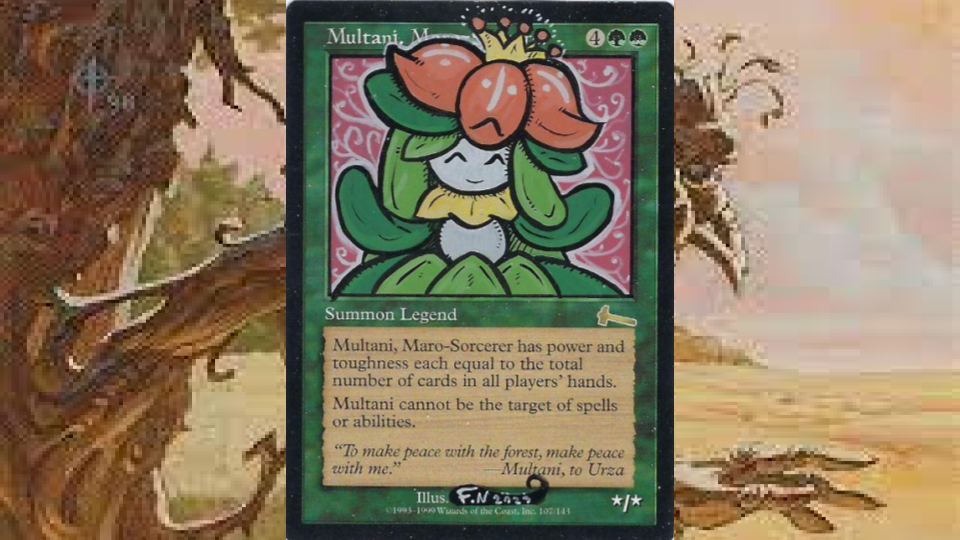Pokedecks: Multani, the Liligant

We Can Dance if We Want To!
One of the topics du jour is signature decks for content creators. Over the next few articles, I'm going to discuss the various PokeDecks that came from my former signature deck, Simic Burn.
Like the Klothys Enchantress deck from a couple weeks ago, Simic Burn showed my affinity for colorshifting strategies, something I share with the illustrious Philomene Gatien, of Do Your Worst fame. Check out her version of Simic Burn!
As for mine, well...it is my most popular deck on Moxfield, but, sadly, it no longer exists in physical form.
One the decks born from its ashes, however, is my Multani Teeter Dance!
Simic Burn, helmed by my all-time favorite goofball commander, Vorel of the Hull Clade
Dropping the blue allowed me to make the deck a little more friendly to newer players. Constantly having their board bounced at best or bounced and then wheeled away at worst is quite a feel-bad for players who're looking for a more combat-centered game, or who are more protective of their creatures. This is especially true for those who enjoy building around specific creature types and need numbers for their cards to do much of anything.
With a plan in mind, I started looking over grass-type Pokemon that fit the vibe. Similar to my Ludicolo Rain Dance deck, this deck would be looking to do a cute little shuffle between hand and grave, in order to use and reuse Storm Seeker
Multani's Abilities
The first challenge was to figure out what Multani brings to the table. Multani wants everyone to have big hands, because its size is equal to the total hand size of all players. Increasing everyone's hand size means increasing the number of answers. Additionally, the commander has shroud instead of hexproof or ward, so we can't buff or alter its abilities. As a result, the size of the commander becomes more of a deterrent to combat than a beatdown option, although that plan B does still exist.
Heartwood Storyteller
Howling Mine
Glademuse
Liligant's Moves
The next challenge is to figure out how to cross the IP from Pokemon to Magic. Liligant is a green grass type, which seems to fit, and it looks like a charming and jovial dancer, perfect for a Pokemon that is designed around getting the opponents to let their guards down. But, how does a distracting dance translate into Magic? Easy! There's a move called Teeter Dance, which confuses opponents and uses their strength against them!
Thwart the Enemy
Pause for Reflection
Moment's Peace
So...Teeter Dance is like Confusion, but that by itself isn't a moveset, nor is it a consistent way to win, at least not in any reasonable time period. How can we make this a functional moveset?
The Perfect Fusion
Since we're not pushing the action forward and creating the threats to respond to, we need to have a strong defensive plan. Not removing threats is a dangerous way to play defense, however. We can hope opponents turn on each other, but using synergy to blank attacks enables us to build the resources needed to find win cons and use the opponents' cards in hand against them. The key to this is an old competitive Pokemon strategy: Parafusion, a portmanteau of Paralysis and Confusion. But if Fogs are the Confusion, what is the Paralysis?
Regrowth
Speaking of returning cards from grave to hand, Wildest Dreams
What are we hoping to return over and over? Storm Seeker
Multani, Use Teeter Dance!
Here is the most recent iteration of the deck, which is still one of my favorites.
Is it an improvement over the original Simic Burn?
How would you update either deck?
And how do they compare to Philomene's takes?
Multani Teeter Dance
View on ArchidektSorceries (22)
- 1 Circuitous Route
- 1 Cultivate
- 1 Edge of Autumn
- 1 Far Wanderings
- 1 Forgotten Lore
- 1 Grow from the Ashes
- 1 Growth Spasm
- 1 Harmonize
- 1 Healing Technique
- 1 Kodama's Reach
- 1 Life from the Loam
- 1 Make a Wish
- 1 Nature's Spiral
- 1 Nissa's Renewal
- 1 Praetor's Counsel
- 1 Rampant Growth
- 1 Recollect
- 1 Regrowth
- 1 Skyshroud Claim
- 1 Summer Bloom
- 1 Verdant Confluence
- 1 Wildest Dreams